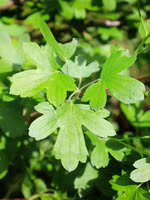Mon-Fri 9am - 5pm Mountain time
Golden Currant vs Grouseberry
Ribes aureum
Vaccinium scoparium
SOLD OUT
CUSTOM GROW
Golden Currant produces berries for jams, jellies, sauces and even pemmican. This currant bush is very dense, allowing for use as a hedge, windbreak, or wildlife habitat.
This plant is also a very popular rootstock to graft popular red and white currant varieties to. The resulting plants are taller, more productive, and easier to harvest.
Grouseberry is a native, low-growing deciduous shrub known for its edible red berries. In early summer, it produces small, urn-shaped flowers ranging from white to pink that attract bees and other pollinators. The berries provide an important food source for many types of wildlife, including game birds such as grouse, which gives the plant its common name. People can also enjoy the berries fresh or in baked goods, though they can be difficult to harvest in large quantities.
Spreading by rhizomes, Grouseberry forms dense, broom-like mats that help stabilize soil and prevent erosion, while also providing cover for ground-nesting wildlife. It is commonly found beneath conifers in open forests, subalpine meadows, and occasionally on rocky slopes in mountainous regions. It is well-suited for naturalization, ecological restoration, and soil stabilization projects.

